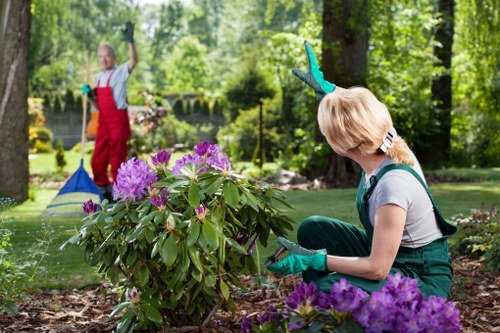Tree Surgeon in Landscape Gardeners

Tree surgeons play a pivotal role in the maintenance and enhancement of landscape gardens. Their expertise ensures that trees not only survive but thrive, contributing to the overall beauty and health of outdoor spaces.
In the realm of landscape gardening, the integration of trees requires careful planning and execution. A tree surgeon provides the necessary skills to manage tree health, structure, and aesthetics, ensuring that each tree complements the garden's design.
Whether it's pruning, disease management, or structural support, tree surgeons bring a level of professionalism and knowledge that is essential for maintaining mature trees in a garden setting.
The Role of a Tree Surgeon

A tree surgeon, also known as an arborist, specializes in the care and maintenance of trees. Their responsibilities extend beyond simple upkeep to include comprehensive tree health assessments and strategic planning for long-term growth.
In landscape gardening, the role of a tree surgeon is multifaceted. They not only ensure the health of existing trees but also assist in selecting and planting new trees that will thrive in the specific environmental conditions of the garden.
Tree surgeons are trained to identify and address various tree-related issues, from pest infestations to structural weaknesses, ensuring the safety and longevity of trees within landscaped areas.
Essential Services Provided

Pruning and Trimming: Proper pruning techniques are essential for maintaining tree health and aesthetics. Tree surgeons remove dead or diseased branches, shape the tree, and promote healthy growth.
Tree Health Assessments: Regular assessments help identify potential issues early. Arborists use specialized tools and knowledge to evaluate the health of trees, ensuring timely intervention.
Tree Removal: In cases where a tree poses a risk due to disease, damage, or structural instability, tree surgeons safely remove the tree, minimizing impact on the surrounding landscape.
Advanced Techniques in Tree Care

Modern tree surgeons employ a range of advanced techniques to ensure optimal tree health. From using specialized pruning tools to implementing pest management strategies, their methods are both effective and environmentally conscious.
Integrating technology, such as climbing gear and aerial lifts, allows tree surgeons to access difficult-to-reach areas, ensuring comprehensive care for each tree.
Additionally, sustainable practices, like using eco-friendly treatments and promoting biodiversity, are integral to responsible tree surgery in landscape gardening.
Benefits of Hiring a Professional

Hiring a professional tree surgeon offers numerous benefits:
- Expertise: Extensive knowledge of tree biology and horticulture.
- Safety: Proper techniques and equipment minimize risks during tree maintenance.
- Efficiency: Professional tree surgeons complete tasks effectively, saving time and resources.
Moreover, professional care ensures that trees contribute positively to the landscape, enhancing both aesthetic appeal and environmental value.
Investing in professional tree surgery services is a crucial step in achieving and maintaining a beautiful, healthy garden.
Importance of Tree Health in Landscapes

Healthy trees are the backbone of any landscape garden. They provide shade, improve air quality, and add to the aesthetic value of the space.
Tree health directly impacts the overall ecosystem of a garden. Healthy trees support a variety of wildlife, contribute to soil stability, and play a role in water management.
Neglecting tree health can lead to a myriad of problems, including pest infestations, disease spread, and structural failures, which can compromise both the safety and beauty of the landscape.
Common Tree Diseases and Pests

Trees are susceptible to various diseases and pests that can affect their health and appearance:
- Rot: Caused by fungal infections, leading to decayed wood and structural weakness.
- Aphids: Small insects that suck sap from trees, weakening them and promoting disease.
- Powdery Mildew: A fungal disease that covers leaves and stems with a white powdery substance.
Early detection and treatment of these issues are essential to prevent widespread damage and ensure the longevity of trees.
Tree surgeons are equipped with the knowledge and tools to identify and manage these problems effectively.
Preventative Measures

Preventing tree diseases and pest infestations involves regular monitoring and maintenance. Practices include:
- Regular Inspections: Routine checks for signs of distress or disease.
- Proper Pruning: Removing affected areas to prevent the spread of disease.
- Healthy Planting Practices: Ensuring trees are planted in suitable conditions with proper spacing and soil health.
Implementing these measures can significantly reduce the risk of serious tree health issues.
Tree surgeons guide gardeners in adopting effective preventative strategies tailored to their specific landscape needs.
Impact on Landscape Aesthetics

Healthy, well-maintained trees enhance the visual appeal of landscape gardens. They provide structure, form, and a sense of scale, contributing to a cohesive and inviting environment.
Proper tree care ensures that trees maintain their natural beauty, with vibrant foliage and strong branches, adding color and texture to the garden throughout the seasons.
Moreover, healthy trees can be focal points in garden design, serving as anchors around which other elements are arranged.
Choosing the Right Tree Surgeon

Selecting a qualified tree surgeon is crucial for ensuring the health and safety of your trees. Consider the following when choosing a professional:
- Certification: Ensure the tree surgeon is certified by a recognized arborist organization.
- Experience: Look for professionals with a proven track record in landscape gardening.
- Insurance: Verify that the tree surgeon has appropriate insurance coverage.
These factors contribute to the reliability and competence of the tree surgeon, providing peace of mind for garden owners.
Engaging a reputable tree surgeon ensures that your landscape garden receives the highest standard of care.
Evaluating Qualifications

A qualified tree surgeon should possess relevant certifications, such as those from the International Society of Arboriculture (ISA). These certifications demonstrate a commitment to ongoing education and adherence to industry standards.
Additionally, practical experience is essential. Ask for references or examples of previous work to gauge the tree surgeon’s expertise and suitability for your specific landscaping needs.
Assessing both qualifications and experience helps ensure that you hire a professional capable of delivering quality tree care services.
Questions to Ask Potential Tree Surgeons

When interviewing potential tree surgeons, consider asking the following questions:
- What certifications and training do you have?
- Can you provide references from previous clients?
- What services do you offer, and how do you tailor them to different types of trees?
These questions help clarify the tree surgeon’s capabilities and ensure they align with your landscape gardening goals.
Clear communication is key to establishing a successful working relationship with your tree surgeon.
Cost Considerations

Understanding the cost structure of tree surgery services is important for budgeting purposes. Factors influencing the cost include:
- Tree size and species
- Extent of work required
- Accessibility of the tree location
Request detailed quotes and ensure that all aspects of the work are covered. Transparency in pricing helps avoid unexpected expenses and ensures that you receive value for your investment.
Remember that quality tree care is an investment in the longevity and beauty of your landscape garden.
Tools and Techniques Used by Tree Surgeons

Tree surgeons utilize a variety of specialized tools and techniques to perform their tasks efficiently and safely. Common tools include:
- Pruning Saws
- Climbing Ropes and Harnesses
- Chainsaws
These tools enable tree surgeons to access and manage different parts of the tree, ensuring comprehensive care.
Advanced techniques, such as aerial lift operations and stump grinding, expand the range of services that tree surgeons can provide.
Safety Protocols

Safety is paramount in tree surgery. Professionals adhere to strict safety protocols to protect themselves, the trees, and the surrounding environment. These protocols include:
- Wearing appropriate personal protective equipment (PPE)
- Regular maintenance and inspection of tools and equipment
- Following established procedures for climbing and cutting
By prioritizing safety, tree surgeons minimize the risk of accidents and ensure that tree care is performed responsibly.
Clients can trust that professional tree surgeons handle tasks with the utmost care and expertise.
Eco-Friendly Practices

Eco-friendly practices are increasingly important in landscape gardening. Tree surgeons contribute by using sustainable methods, such as:
- Implementing organic pest control measures
- Recycling green waste materials
- Promoting biodiversity through diversified planting
These practices support environmental health and ensure that landscape gardens are both beautiful and sustainable.
Choosing a tree surgeon committed to eco-friendly practices benefits both your garden and the broader ecosystem.
Innovations in Tree Surgery

Advancements in tree surgery are enhancing the effectiveness and efficiency of tree care. Innovations include:
- Use of drones for tree health monitoring
- Adoption of precision pruning techniques
- Development of biodegradable tree care products
These technological advancements enable tree surgeons to provide higher quality services, ensuring the vitality and resilience of trees in landscape gardens.
Staying abreast of industry innovations allows tree surgeons to offer the best possible care to their clients.
Safety Considerations in Tree Surgery

Safety considerations are critical in tree surgery to prevent accidents and ensure the well-being of both the tree surgeon and the property owner. Key safety measures include:
- Proper use of safety equipment
- Adherence to safety guidelines and regulations
- Thorough site assessments before starting work
Implementing these safety measures reduces the likelihood of injuries and property damage during tree surgery operations.
Clients can have confidence in the professionalism and responsibility of certified tree surgeons.
Risk Management

Effective risk management involves identifying potential hazards and implementing strategies to mitigate them. Tree surgeons achieve this by:
- Conducting detailed site evaluations
- Planning work processes to avoid high-risk scenarios
- Using appropriate tools and techniques to manage heavy or unstable branches
By proactively managing risks, tree surgeons ensure that tree care is performed safely and efficiently.
Clients benefit from reduced risks and enhanced safety when engaging with professional tree surgeons.
Emergency Preparedness

In the event of unexpected incidents, such as severe weather or equipment failure, tree surgeons are prepared to respond swiftly and effectively. Emergency preparedness protocols include:
- Having contingency plans in place
- Training staff in emergency response procedures
- Maintaining clear communication channels with clients
These measures ensure that any emergencies are handled with minimal disruption and maximum safety.
Clients can rely on tree surgeons to manage unforeseen challenges professionally and responsibly.
Maintaining Equipment

Proper maintenance of equipment is essential for the safe and effective performance of tree surgery tasks. Regular maintenance practices include:
- Inspecting tools for wear and tear
- Sharpening blades and ensuring machinery is in good working condition
- Storing equipment securely to prevent damage
Well-maintained equipment not only enhances the quality of tree care but also reduces the risk of accidents.
Professional tree surgeons prioritize equipment maintenance as part of their commitment to safety and excellence.
Common Tree Problems and Solutions

Trees in landscape gardens can encounter various problems that affect their health and appearance. Common issues include:
- Yellowing Leaves: Often a sign of nutrient deficiency or disease.
- Cracked Branches: Indicative of structural weakness or pest damage.
- Excessive Growth: Can lead to overcrowding and impede healthy development.
Addressing these problems promptly is essential for maintaining the vitality of trees and the overall beauty of the garden.
Tree surgeons provide targeted solutions to effectively manage and resolve these common tree issues.
Tackling Nutrient Deficiencies

Nutrient deficiencies can manifest as yellowing leaves, stunted growth, or poor flowering. Tree surgeons diagnose these issues by analyzing soil composition and tree health.
Solutions may include soil amendments, fertilization, and adjusting watering practices to ensure trees receive the necessary nutrients for optimal growth.
Proper nutrition supports robust tree health, enhancing resilience against diseases and environmental stressors.
Managing Structural Weakness

Structural weaknesses in trees, such as cracked branches or hollow trunks, can pose significant risks. Tree surgeons assess the extent of these issues and determine the best course of action.
Solutions often involve strategic pruning, cabling, or bracing to reinforce weak areas and prevent potential failures.
Maintaining structural integrity is crucial for the safety of both the tree and the surrounding environment.
Controlling Excessive Growth

Excessive growth can result in tangled branches, reduced airflow, and increased vulnerability to pests and diseases. Tree surgeons manage this by:
- Regular pruning to maintain desired tree size and shape
- Removing overcrowded branches to enhance light penetration and airflow
- Implementing growth-limiting techniques when necessary
These measures ensure that trees remain healthy, aesthetically pleasing, and well-integrated into the landscape garden.
Professional management of tree growth contributes to the overall harmony and functionality of the garden design.
Best Practices in Tree Maintenance

Implementing best practices in tree maintenance is essential for sustaining the health and beauty of trees in landscape gardens. Key practices include:
- Regular Inspections: Routine checks help identify issues early, preventing minor problems from escalating.
- Proper Pruning: Ensures balanced tree growth and removes potential hazards.
- Soil Management: Maintaining soil health through proper watering, mulching, and fertilization.
Adhering to these practices promotes robust tree health and longevity, enhancing the overall landscape.
Tree surgeons guide gardeners in adopting these best practices tailored to their specific tree species and garden conditions.
Watering Techniques

Effective watering is critical for tree health. Overwatering can lead to root rot, while underwatering can cause stress and reduced growth. Tree surgeons recommend:
- Deep, infrequent watering to encourage strong root systems.
- Using drip irrigation systems for precise water delivery.
- Adjusting watering schedules based on seasonal needs and weather conditions.
Proper watering techniques ensure trees receive adequate moisture without risking water-related issues.
Professionals assess each tree's specific watering requirements to optimize health and growth.
Mulching Strategies

Mulching benefits trees by retaining soil moisture, regulating temperature, and suppressing weeds. Tree surgeons utilize mulching strategies such as:
- Applying organic mulch materials like bark or compost.
- Maintaining appropriate mulch depth to avoid root suffocation.
- Ensuring mulch is spread evenly around the tree base.
These strategies enhance soil health and create a favorable environment for tree growth.
Proper mulching contributes to sustainable landscape gardening practices.
Seasonal Maintenance Tasks

Different seasons present unique maintenance challenges and opportunities. Tree surgeons recommend the following seasonal tasks:
- Spring: Pruning, pest control, and fertilization to support new growth.
- Summer: Monitoring for drought stress and maintaining adequate watering.
- Autumn: Cleaning fallen leaves and preparing trees for winter.
- Winter: Protecting trees from frost and winter damage.
Adapting maintenance practices to seasonal changes ensures trees remain healthy year-round.
Seasonal adjustments are essential for addressing the dynamic needs of trees in landscape gardens.
Integrating Trees into Landscape Design

Integrating trees into landscape design involves careful selection and placement to create a harmonious and functional garden. Tree surgeons collaborate with landscape gardeners to:
- Choose tree species that complement the garden's aesthetic and environmental conditions.
- Determine optimal placement for shade, visual appeal, and structural balance.
- Plan for future growth to prevent overcrowding and ensure long-term beauty.
Thoughtful integration of trees enhances the overall design and functionality of landscape gardens.
Professional guidance ensures that trees are positioned to maximize their positive impact on the garden.
Species Selection

Selecting the right tree species is fundamental to successful landscape gardening. Factors to consider include:
- Climate suitability and hardiness zones.
- Soil type and drainage conditions.
- Desired size, shape, and growth rate.
Tree surgeons assist in identifying species that align with the garden's environmental conditions and design objectives.
Proper species selection ensures that trees thrive and contribute positively to the landscape.
Placement Strategies

Effective tree placement enhances both aesthetics and functionality. Strategies include:
- Positioning trees to provide shade in high-traffic areas.
- Creating focal points with visually striking tree species.
- Ensuring adequate spacing to accommodate future growth.
Strategic placement considers factors like sunlight exposure, wind patterns, and proximity to structures.
Careful planning ensures that trees integrate seamlessly into the overall landscape design.
Long-Term Planning

Long-term planning involves anticipating the future growth and development of trees within the landscape garden. Tree surgeons help by:
- Mapping out the mature size and spread of trees.
- Considering how trees will interact with other garden elements over time.
- Planning for maintenance needs as trees grow.
This proactive approach prevents issues related to overcrowding, structural interference, and maintenance challenges.
Long-term planning ensures that trees remain healthy and aesthetically pleasing throughout their lifespan.
Conclusion

Incorporating a professional tree surgeon into your landscape gardening endeavors is a wise investment. Their expertise ensures that trees are healthy, safe, and beautifully integrated into your garden design.
From routine maintenance to addressing complex tree health issues, tree surgeons provide invaluable services that enhance the overall quality and sustainability of landscape gardens.
If you’re looking to elevate your garden’s appeal and ensure the longevity of your trees, contact us today to book your professional tree surgery service.